|
|
| |
|
| |

|
Part 1 of a six part edit of the Lang
Lines video programme about long line
fishing at the close of the nineteenth
century. It was filmed by Alan White and
is narrated by Bill Torrance.
It describes how the combination of the
silting up of the harbour and the introduction
of steam trawling led to the demise of
commercial fishing in Aberdeen.
|
Part 2 describes the wintering
of the larger Collieston yawls
on the Ythan estuary.
It also includes an extract
from the award winning film
“The Last Fisherman”
showing Norman Grant fishing
for cod in the 1960s. His technique
is much the same as would have
been used in the 1900s.
It closes showing how the hooks
were attached to the lines.
|
 |
|
 |
Part 3 describes the work involved in
baiting the lines and how the women used
to carry their men to the boats. It closes
with a sequence filmed aboard the Scottish
Fisheries Museums Reaper – a larger
version of the traditional “zulu”
design of yawl that would have fished
from Collieston. |
Part 4 begins with Norman Grant
hauling in his lines at sea and
continues by showing how fish were
gutted and cleaned before being
packed into creels to be carried
and sold around the countryside
by Collieston fish wives. |
 |
|
 |
Using archive footage, Part 5 shows
the work involved in making the famous
Collieston Speldings.
It continues to tell how the minister
once had economic ambitions for the
village including the construction of
a branch railway line and a bank in
the village.
|
This final part describes again
how the building of the Pier led
to the silting up of the harbour.
It closes with a tribute to the
many fishers who lost their lives
plying their trade at the Lang Lines. |
 |
|
 |
Steve & Jock Ritchie reminisce about
their Aunt Jean who worked as fishwife
Colvid0001
|
Malcolm Forbes demonstrates the
hydraulic technique of sinking wooden
poles into sand that was developed
during WW2 to prevent enemy planes
and gliders from landing on the
long beaches on Scotlandís east
coast. Colvid0031 |
 |
|
 |
Netsman Malcolm Forbes talks about the
decline in salmon fishing along the
coast between Aberdeen and Forvie Colvid0041
|
The general location of the salmon
bothy and fishery along the shore
of Forvie Moor. Colvid0040
|
 |
|
| and describe how
many Collieston fisher families
moved to Torry. |
 |
|
 |
, and talk about speldings.
|
|
|
|
|
|
| |
|
|
| |
Yawls
landing prior to building of the Pier |
|
| |
| |
Collieston
circa 1890, prior to the building of the Pier and looking
north to the part of the village known as the Cliff.
The main focus is the fishing boats returning to the
natural harbour under sail.
Sailing as far as Belhelvie, these smaller haddock boats
would each have had a crew of three or four men who
would often have had to row there and back when there
was no wind to assist them.
One of the boats is carrying a jib as well as the lugsail.
|
| |
|
 |
| |
|
|
 |
| Circa
1890 women stand ready to carry their menfolk to their
boats |
| |
Circa 1890,
the women, Sara Robertson (nee Ross), Maggie Walker
and Annie Wilson (wife of Sandy ‘Da’), have
each removed their stockings and shoes and have their
skirts hitched up ready to wade into the cold, icy water
to lever the boats forward with their backs. Afterwards
they would carry out the heavy stones for ballast.
Their final task would be to carry the men, ‘Bricky’
(John) Walker, Sandy ‘Da’ Walker, Tam Walker
and Alex ‘Rossie’ Ross out to the boat,
‘The Vigilant’, on their backs. By carrying
the men, the women would ensure that the men’s
leather boots would remain dry. Launching the yawls
was indeed a hard job for the women.
Houses that subsequently fell into decay and were later
demolished are visible behind the boat.
|
|
|
|
| |
|
|
| |
Fishwives gutting/cleaning fish
on the shore. |
|
| |
| |
Circa
1890, prior to the building of the Pier, a group of
women on the rocky foreshore after a catch of fish has
been brought ashore. The fish are spread on the rocks
in front of the women whose task now is to clean and
gut the fish before the hungry gulls appear.
The women are cleaning and gutting the fish on the shore
below the part of the village known as ‘The Bog’.
Houses that subsequently fell into decay and were later
demolished are visible to the rear of the women.
|
| |
|
 |
| |
|
|
 |
| Fishwives
gutting fish on the apron area of the newly constructed
Pier. |
| |
Circa 1895
four fishwives, Libby Mitchell, Mrs Mitchell, Jean Ritchie
and May Ritchie, are busy cleaning and gutting fish
on the apron area of the newly constructed Pier. Their
traditional wicker woven baskets, murlins, full of fish,
are clearly visible nearby.
Behind the women is the area of the village known as
Low Town where a recently built row of two storey cottages
runs across the middle of the photograph. These cottages,
originally called Jubilee Terrace, were built in 1887,
the year of Queen Victoria’s Golden Jubilee.
Behind Jubilee Terrace can be seen Seaview, home of
the Ritchie family, and the Dairy House. The roof of
the village shop is also visible in the background.
|
|
|
|
| |
|
|
| |
'The Boatie Shore' |
|
| |
| |
Between
1894 and 1899, three boats, on the part of the beach
known as ‘the boatie shore’, are in the
process of being beached and are being hauled up onto
the shore by a group of men and women.
It would appear to have been a successful fishing trip
judging by the number of seagulls assembled on the rocks
near the harbour entrance eagerly waiting to feed on
the scraps which will be discarded when the fish are
cleaned and gutted.
Part of the recently built Pier can be seen to the left
in the background.
|
| |
|
 |
| |
|
|
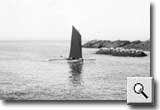 |
| The
Harbour |
| |
A yawl sails
into the harbour at the end of the 19th Century prior
to the construction of the Pier in 1894. The Pier was
built because of the increasing prosperity of the fishing
industry and records show that, at that time, some 165
men were working 63 fishing boats.
Ironically, it was the building of the Pier that led
to the harbour silting up. Small herring boats soon
became outmoded and the young men left to join larger
boats in Torry, Aberdeen.
Soon there were not enough men left to haul the large
line boats up the beach. By 1900 only 16 boats were
left, by 1929 only 14, and the few remaining fishermen
were well in to middle age.
|
|
|
|
| |
|
|
| |
Fishwives
gutting fish near the shore |
|
| |
| |
A
group of fishwives are gutting fish near the foreshore
circa 1900. Their traditional hand woven wicker baskets
lie on the rocks nearby and a small cobble boat is clearly
visible behind them.
After the men had brought the catch of haddock and whiting
ashore, it was the women’s job to gut, wash and
scrub the fish with a brush made of heather stems bound
together. After splitting, the fish were salted, laid
in a circle head out, tail in the centre, and then laid
on racks to dry.
The dried fish were then called speldings. Sold for
one penny each for a large one and one half penny for
a small one, the demand for this famous Collieston delicacy
often exceed the supply and sometimes speldings had
to be posted on to the customer when a fresh supply
was available.
|
| |
|
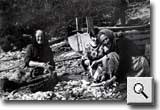 |
| |
|
| |
|
|
| |
Fishing |
|
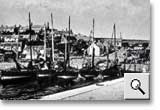 |
| |
| The
Collieston fishing fleet of larger, tall masted, yawls
in port circa 1900. Some of the fishermen’s gear
can be seen lying on the pier. Beyond the yawls, the
gable end of the cottage now known as ‘Buckies’
is easily identifiable, as is the line of the road running
from the harbour up to the village. |
| |
In wintertime
the yawls were taken to the shelter of the Ythan Estuary
|
| |
|
|
| |
|
|
| |
| Fishwife |
| |
A fishwife
called Maggie Ross circa 1925 dressed in clothes typically
worn by the women residents of the village at that time.
The hardwearing leather boots and woollen stockings
were required to keep her feet warm and dry and protected
from the rough roads.
The skirt, jacket and headscarf were woollen and would
have helped keep the cold, north winds at bay. On her
back can be seen the creel which would have been filled
with fish and carried round the countryside where she
would have either sold her fish or used them as barter
for meat and eggs.
To keep the farm produce separate from the fish, she
would have carried a separate basket.
|
| |
|
 |
| |
|
|
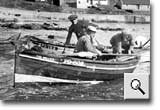 |
Some
of the village fishermen and their boats circa 1935.
The boat in the foreground, ‘The Nellies’,
was registered in Peterhead and had the registration
number PD602.
By the mid 1930’s line fishing was only carried
out in small boats. This was due to the build up of
sand on the foreshore, caused by the construction of
the Pier at the end of the 19th century, which made
it impossible for the bigger boats to come ashore.
In the background, above the Pier, is the area of the
village known as the Cliff and the cottage which can
be seen slightly right of centre is the one in which
T E Lawrence stayed in 1930. It has received some care
and attention and is now harled and white washed.
|
|
|
| |
| |
|
|
| |
|
|
| |
James
Walker who was known as ‘Jimmicky’. ‘Jimmicky’
was a fisherman who lived in the village and he is seen
here preparing his lines ready to shoot from a wicker
skull raised on a specially made work ‘bench’.
Behind ‘Jimmicky’ is a shed which has been
painted with layer upon layer of black Archangel tar.
|
| |
|
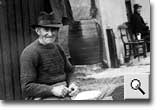 |
| |
|
|
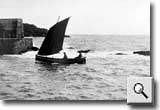 |
A yawl sails into Collieston harbour
at the beginning of the 20th Century by which time
the fishing industry in Collieston was in decline.
After the Pier was built in 1894, the harbour began
to silt up, small herring boats became outmoded
and the young men left to join larger boats working
from Torry, Aberdeen. Soon there were not enough
men left to haul the large line boats up the beach.
By 1900 only 16 boats were left, by 1929 only 14
small boats, and the few remaining fishermen were
well into middle age. Norman Grant, who died in
1971, represented the end of the line as far as
commercial fishing out of Collieston was concerned.
|
|
|
|
| |
|
|
| |
Fishing |
|
| |
| |
Alexander
Ritchie mending a traditional wicker woven basket, known
as a murlin, circa 1935. Known to everyone as ‘Cottie’,
Alexander Ritchie lived in the Hightown area of the
village. His mother was a fishwife who used to travel
round the neighbouring farms selling the fish caught
by her husband or bartering them for farm produce.
On one of her travels, during the latter stages of pregnancy,
the onset of labour pains forced the woman to stop at
Cotehill Farm, just over one mile north of Collieston.
She duly gave birth to a baby boy and left him in the
capable hands of the farmer’s wife while she continued
on her way to sell her wares, collecting the new addition
to the Ritchie family on her way home.
The baby, christened Alexander, was appropriately nicknamed
‘Cottie’ and answered to that name for the
remainder of his days. Alexander ‘Cottie’
Ritchie died, aged 76 years, on 22nd April, 1945.
|
|
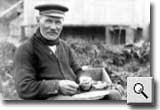 |
| |
|
|
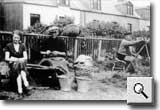 |
Traditional
long line fishing continued in Collieston into the 1950s.
By the end of World War 2 there were very few boats
fishing full time, it was however still very much a
family affair.
A young female relative is seated next to Andrew John
Walker. He is preparing bait ready to lay it into a
wicker skull, two other skulls are sitting on the fence
behind him. The bait, either mussels, mackerel, or lug
worm is in the enamel plate on his knee. Another, more
elderly relative is seated working on a line suspended
from a tripod frame.
Behind the group is the row of two storey houses known
as Jubilee Terrace. The Walker’s shed with its
luxury of running water is to the left of Andrew
John.
The dormer windows on the upper storey are the original
– they have subsequently been “modernised”.
|
|
|
| |
|
|
| |
Fishing |
|
| |
| |
Circa
1959 the Ingram brothers, Jimmy, Jack and Dick, are
doing some maintenance work on Dick’s boat ‘Gipsy
Queen’. By the mid 1950’s the beach had
become a popular spot with both locals and tourists,
many of whom can be seen either sitting on the sand
and rocks at the foreshore or paddling in the sea.
Beyond the Pier several houses have either been renovated
or extended, including the house in which Lawrence of
Arabia stayed. Painted white and with a raised roof
and much enlarged gable, it stands out in the centre
of the top third of the photograph.
The house to its right has also been extended with bay
windows on the ground floor and dormer windows on its
now raised roof.
|
|
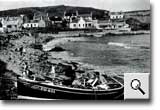 |
| |
|
|
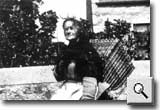 |
| Fishwife |
| |
Rachel
King Walker was the wife of Thomas 'Tooley' Walker
who owned the Peterhead Registered boat 'The Ella
Keith'. She is seen here standing outside Ebenezer
Cottage the home of her sister-in-law, Jessie King,
circa 1910. Carrying a creel on her back, Rachel has
a shawl wrapped over her shoulders to protect them
from the heavy weight of the creel filled with fish.
Wearing a striped skirt, knitted jumper, hessian apron
and stout shoes, Rachel would have had to walk many
miles round the neighbouring countryside to sell her
fish or barter them for fresh produce from the local
farms.
|
|
|
|
| |
|
|
| |
Fishing |
|
| |
| |
Three men
after an early morning fishing trip in 1999. To the
rear of the men, Ronnie Chaplain, Mike Wallace and Ken
Ingram, small boats are clearly visible tied to moorings
near the ‘boatie shore’ at the foot of the
Braehead.
Commercial fishing in Collieston is now a thing of the
past but it is still a popular pastime with both residents
and visitors alike, although it is now only undertaken
when the weather is fair and the sea calm. Gone are
the days when fishing boats had to be taken out in all
weathers and women had to carry their men-folk out to
the boats to prevent their leather sea boots from getting
wet.
Herring and flounders are still caught and there is
still a small private smokehouse in the village where
the herring are kippered. Speldings, however, are no
longer made and the days of Collieston’s famous
Spelding Teas have indeed passed into history.
|
| |
|
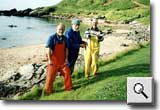 |
| |
|
|
| |
Speldings |
|
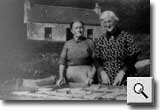 |
| |
The
fishwives are standing in the Bog area of Collieston
beside fish drying on racks circa 1910. Gutted and split
the fish were salted, laid in a circle head out, tail
in the centre, and then laid on racks to dry.
The dried fish were then called speldings. Sold for
one penny each for a large one and one half penny for
a small one, the demand for this famous Collieston delicacy
often exceed the supply and sometimes speldings had
to be posted on to the customer when a fresh supply
was available.
|
|
|
| |
|
|
| |
|
|
| |
| Spelding
Teas |
| |
The Collieston
Tearoom was very popular with visitors to the village
during the 1920’s and 30’s. It was situated
on the Brae Head next to the village bakery and, for
the princely sum of one shilling and sixpence per person,
a mouth watering afternoon tea was provided.
The waitress, smartly dressed in black with a white
apron and frill, would bring the purchaser one of Collieston’s
famous Spelding Teas consisting of oatcakes and butter,
speldings, home made cakes and a pot of tea.
|
| |
|
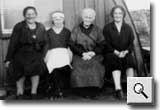 |
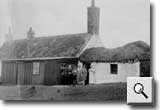 |
The
bakery with Mr A Walker as proprietor, provided the
villagers with their daily supply of freshly baked big
plain loaves and mouth watering shortbread, baked to
Mrs Stock’s recipe.
During the summer months of the 1920’s, visitors
flocked to the bakery’s Tearoom to partake of
the famous Spelding Teas which consisted of oatcakes,
butter, grilled speldings, tea and cakes, all for the
princely sum of one shilling and sixpence.
|
| |
|
|
| |
|
|
| |
| Speldings |
| |
Circa 1925,
the Tea Room, which was located in the High Town area
of the village in the house now known as the Bakery.
It’s popularity was based largely on the ‘Spelding
Teas’ that helped to attract visitors to the
village. People also used to buy speldings to take
away.
The building is a single storey rubble and harled cottage
with a turf roof and wooden extensions. A feature of
the building is the very high chimney which would have
created extra up draught for the bakery oven.
The proprietor, A Walker, is standing outside the tearoom,
posing for the camera, and is wearing a white apron.
|
| |
|
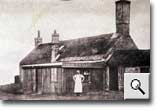 |
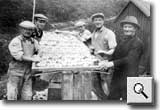
|
Fishermen
Four fishermen are standing beside a rack of speldings. After
the men had brought the catch of haddock and whiting ashore,
the women had to gut, wash and scrub the fish with a brush
made of heather stems bound together.After splitting, the
fish were salted, laid in a circle head out, tail in the centre,
and then laid on racks to dry. The dried fish were then called
speldings. Sold for one penny each for a large one and one
half penny for a small one, the demand for this famous Collieston
delicacy often exceed the supply and sometimes speldings had
to be posted on to the customer when a fresh supply was available.
Behind the men a shed is clearly visible.
These ‘black sheds’, so called because of
their thick coatings of Archangel tar were scattered throughout
the village and would have been where the fishing gear
was kept.
|
A posed postcard photograph
of fishwives
Two fishwives and a well-dressed Edwardian gentleman. Taken
circa 1910 a fishwife with a creel on her back stands to the
left of the picture looking seaward past speldings drying
on nearby rocks.
A well-dressed Edwardian gentleman and another fishwife, known
as Fish Meggie, are seated on the rocks with the sea behind
them. In the foreground is Fish Meggie’s empty creel
which she will fill with the speldings when they are fully
dried.
Fish Meggie and her fellow fishwife will then carry their
creels full of speldings around the local countryside either
selling their wares or bartering for meat and eggs. To keep
the farm produce separate from the fish, the fishwives would
have carried a separate basket.
|
 |
| |
|
|
| |
| The
'Howdie Wifie' |
| |
The ‘Howdie
Wifie’ (midwife) known as Jinsy Meggie at the
beginning of the 20th century. The clothes worn by Meggie
were typical of those worn by the women residents of
the village at that time.
Hardwearing leather boots and woollen stockings were
required to keep her feet warm and dry and protected
from the rough roads as she travelled around the countryside.
An apron was worn on top of her woollen skirt to help
keep it clean.
A woollen shawl and bonnet completed the outfit and
would have helped keep the cold, north winds at bay.
|
| |
|
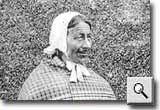 |
| |
|
|
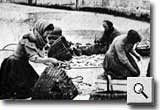 |
| Gutting
Fish |
| |
Fishwives
are busy cleaning and gutting fish on the apron area
of the recently constructed Pier circa 1900. Their traditional
hand-woven wicker baskets, full of fish, are visible
nearby.
To the rear of the Pier is the area of the village known
as the Cliff. The buildings are of rubble and quarry
stone construction, harled with a lime-based mortar.
Some of the houses fell into decay and were later demolished
but many were preserved and modernised.
The grassy mound behind the houses is called the Rivie,
the promontory dividing Cransdale from Collieston. This
was where the 'herdie lad' looked after the cows until
it was time to take them down through the village and
herd them up to the byre near the dairy to be milked.
|
| |
|
|
| |
|
|
| |
| Gutting
fish on the 'boatie shore' |
Fishwives
hard at work on the ‘boatie shore’ at the
beginning of the 20th Century. After the men had brought
the catch ashore it was the women’s job to sort,
gut, clean, split and salt the fish.
The women’s traditional hand woven wicker baskets,
known as murlins, are clearly visible lying on the rocky
foreshore.
The gulls, hovering overhead waiting for a feast when
the women have finished, will make sure that not a scrap
of food is left.
|
| |
|
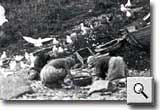 |
| |
|
|
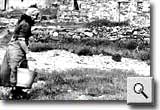 |
| Sorting
the catch |
Two women
busy at work on the foreshore circa 1890, prior to the
building of the Pier. The woman on the right is sorting
the catch of fish in preparation for gutting and cleaning.
The one on the left is carrying a bucket of water, fetched
from the Bog Wall which provided the entire village
with its water supply at the time.
The houses, clearly visible behind the women, are situated
in the area known as the Cliff. Some of the houses subsequently
fell into decay and were later demolished but many were
preserved and modernised.
|
| |
|
|
| |
|
|
| |
| Cleaning
the fish |
Fishing
was the predominant way of earning a living for most
of the families in Collieston during the late 19th and
early 20th Centuries. Both men and women had an important
role to play.
The men would bait the lines with mussels and pieces
of mackerel, go out in the early morning to lay the
lines and then wait patiently for the fish to bite.
Once the catch was brought ashore it was usually the
women who had the job of cleaning the fish.
The women seen here circa 1910 are busy at work on the
rocky foreshore gutting, washing and scrubbing the fish
with a brushes made out of heather stems bound together.
|
| |
|
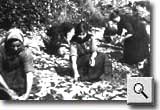 |
| |
|
|
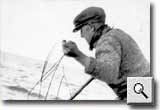 |
| Setting
a long line |
| |
Jimmy Ingram
is setting the lines circa 1950. Having already baited
the lines with either mussels, lug worm or pieces of
mackerel, Jimmy would go out in his boat in the early
morning to lay the lines and then wait patiently for
the fish to bite.
A traditional wooden skull, from which the lines were
shot, is clearly visible at Jimmy’s feet.
|
| |
|
|
| |
|
|
| |
| Fish
wife’s Creel |
| |
Woven from
willow, these wicker creels (full of upwards of 50
kilos of fresh fish) were carried on the backs of fishwives
as they sold the daily catch around the countryside.
The
load was supported by a hessian strap attached across
the women’s shoulders.
|
| |
|
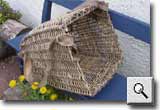 |
| |
|
|
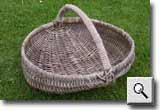 |
| Murlin |
| |
Wicker
murlins or flat tray-like baskets were used to coil
the long lines during the redin, or removal of the
old bait, prior to the lines being baited once more
and set neatly into either wicker or wooden skullls
ready for the fishing.
|
| |
|
|
| |
|
|
| |
| A
Family Haul a Small Yawl up onto the Beach |
| |
Making
a living from fishing involved the whole family. This
included quite literally pulling together to haul the
smaller, but still heavy, wooden yawls up from the
water, over the sand and onto the shelter of the “boatie
shore”.
|
| |
|
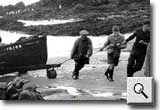 |
| |
|
|
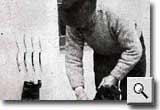 |
| Oiling
Sea Boots |
| |
Before
the invention of waterproofed rubber, sea boots were
made of leather. Fishermen kept them waterproof by
the regular application of oils such as Dubbin.
|
| |
|
|
| |
|
|
| |
| A
view over the Harbour |
| |
Circa 1910,
looking at the northerly part of the village. On the
horizon, behind the grassy mound known as the ‘Rivie’,
Slains Kirk and Collieston School are clearly visible.
In the foreground a beached yawl lies on the rocky foreshore
while two more yawls can be seen on a part of the foreshore
where sand is beginning to accumulate after the recent
construction of the Pier.
The houses at the foot of the ‘Rivie’ are
built on the area of the village known as the Cliff.
Some of the houses subsequently fell into decay and
were later demolished but many of them were preserved
and modernised.
|
| |
|
 |
| |
|
|
 |
| Fishwives
sorting the catch |
| |
Circa 1905,
fishwives and fishermen from the village. The fishwives
are Annie Wilson, Aggie and ‘Old May’, while
standing nearby are the fishermen known as ‘Captain
Sandy Ad’ and ‘Jock Retch’.
The well-dressed lady is Molly Clark who, along with
several other visitors is watching the fishwives hard
at work on the Pier as they sort the catch of fish and
get them ready for cleaning and gutting.
To the right of the Pier is the area of the village
known as the Cliff and the line of the road running
from the harbour up to the village is clearly identifiable.
Some of the houses subsequently fell into decay and
were later demolished but many were preserved and modernised.
|
| |
|
|
 |
|
|
copyright collieston's century
2003 |
|
|